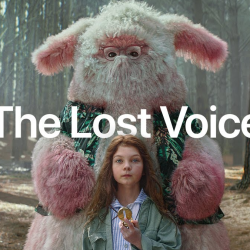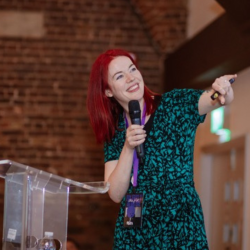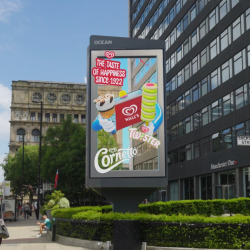In the marketing ecosystem, there is a lot of digital noise constantly being created
Standing out can be difficult. One way to cut through the digital noise is personalization, which can give a business’ communications greater resonance and impact, to help them secure valuable mindshare with their audience. In a B2B marketing context, personalization can assist with several parts of the equation, including message alignment across teams, increased campaign effectiveness, and increased upsell opportunities. Given businesses spend an average of a quarter of their marketing budget on content creation, this is a key area they cannot afford to get wrong.
Of course, simply personalising short-form content — such as emails — is not challenging for businesses, and there is no doubt that personalized content works. There are, however, two significant barriers for many businesses when it comes to scaling their personalized content. These are effort and cost.
These barriers only become more apparent when businesses take the step towards personalising in-depth content, such as reports, magazines, brochures and slide decks. This has traditionally been both expensive and difficult to do and, as a result, many businesses do not even consider it as a possibility. Indeed, for many smaller businesses, personalizing long-form content has historically been an impossibility.
There’s no doubt personalisation drives strong business results
With 35% of Amazon purchases related directly to their recommendation tool. Similarly, Slideshare found that 80% of consumers are more likely to buy from a brand that provides a tailored experience. In our own work, we’ve found content featuring a personalized front cover sees a 49% lower bounce rate than non-personalised content. This, however, is table stakes as far as content personalisation is concerned and businesses can take personalization far further to speak directly to their audience, and can also take advantage of technology solutions to power their content at scale.
Personalisation works because it produces something called the cocktail party effect, which mirrors what happens when you’re talking to someone and then hear your name in a different conversation. Your attention is drawn to your own name, which is very hard to ignore.
Of course, the 1:1 personalization required to generate this effect in an individual reader is not overly challenging to attain. But, when marketers choose to take this approach in a campaign operating at scale, they need to apply the cocktail party effect to the whole room and guarantee that everyone is engaged with the content used to market to them. This is where marketers need to have access to measurable results of their marketing efforts to ensure their spend delivers strong, concrete results.
How much is being spent to create this content? How much can businesses save?
Investis Digital estimates that content marketing strategies can cost anywhere between $5,000-$50,000 per month, and beyond. This is a huge amount for businesses to invest in marketing strategies that don’t deliver tangible, measurable results. But personalized content marketing doesn’t need to break the bank. Using tools that allow for content personalisation to be automated (and eventually scaled) can save businesses significant sums of money and can save marketing teams from spending an age creating content without any measurable outputs. Informa Markets, for example, was able to reduce the time spent by its marketing teams on content creation by 90%, which equated to 1,540 hours saved for each member of the team, equating to a yearly saving of over $138,000, while delivering high-quality, personalized marketing material. And, perhaps, more importantly in changing the format their sales proposals took from PDFs to digital documents, they were able to obtain measurable analytics data telling them exactly how each document performed.
Most importantly, though, content marketing strategies need to be able to scale with a business’ needs. Personalisation on a small scale, such as sales follow-ups — can be carried out manually, but as soon as this marketing outreach expands beyond a small mailing list, this time-consuming approach becomes infeasible. Community Brands transformed their sales campaigns by integrating automated, personalised follow ups to key prospects. The automated nature of these allows them to scale as needed and, since they are also housed in trackable documents, Community Brands’ sales teams had full visibility on which content was of interest to their prospects, allowing them to ensure they were delivered interesting, relevant content. This approach ensured read time rose from 2 minutes to an average of 4 minutes 42 seconds for each document, while their bounce rate dropped from 33% to 15%.
The ability to unlock huge performance increases with automated personalization offers businesses a crucial opportunity to strengthen their marketing strategy while also potentially reducing their costs, a benefit that cannot be overlooked in the current economic climate. However, these performance boosts can be taken even further by using deep personalisation to ensure the content delivered to an individual reader is tailored to their preferences, ensuring its relevance and greatly increasing their likelihood of engaging with it.
What does an ideal personalised experience look like?
From the outset, personalising in-depth content requires a complete rethink of the content production process. Long-form content has to be designed with personalization in mind. This new approach requires businesses to create modular content to drive their marketing communications. This approach ensures any long-form piece of content is made up of several shorter components that can be included or omitted based on a reader’s previous preferences. This approach allows for deep personalisation. Instead of simply changing the name at the top of each document, deep personalisation ensures readers are presented with a tailored piece of content that corresponds to their needs. This approach is highly effective, delivering significant drops in bounce rates of up to 64%. Additionally, by personalising their content to this extent, marketers can also increase engagement by 43%, which is an improvement of 9%, compared to standard personalization methods.
The more relevant your content the more deeply people will engage
And when it comes to engaging senior decision makers whose time is extremely limited, marketers have to be able to deliver the maximum amount of relevant information in the smallest amount of time. Indeed, the numbers back this approach up. Unit4 leveraged its analytic data to make certain that every customer received content relevant to their needs, obtaining 8x more engagement and 4x more read time with their customer onboarding documents, while also reducing bounce rates by 50% using personalised content. Interestingly, though, deeply personalized content drives not only ‘passive‘ engagement with content, but also active interactions, with these increasing by 42% when contrasted with non-personalised content.
The bottom line
These results may seem like they’d incur significant costs. That doesn’t need to be the case. By re-evaluating their content creation process to prioritize the creation of modular content that can be fitted together with other content like the pieces of a puzzle, brands can build themselves a bank of material they can share with their audience. Using the right tools, they can also smooth their processes to automate personalised content with a few clicks to obtain huge results for their business.
Featured image: fauxels / Pexels































